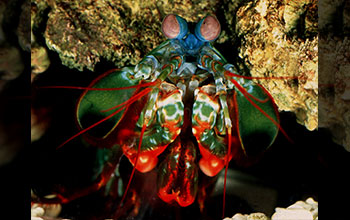Multimedia Gallery
Mantis shrimp (Odontodactylus scyllarus)
Mantis shrimp (Odontodactylus scyllarus). Crustaceans of this genus have recently been shown to be capable of circular polarization vision, a new visual modality in the animal kingdom.
More about this Image
Also known as stomatopods, mantis shrimp are large and particularly violent marine crustaceans that aren't actually a kind of shrimp, but look something like one.
The discovery was made by Justin Marshall of the University of Queensland in Australia, who describes circular polarized light (CPL) as a spiraling beam that spins either to the left or the right. Using circular polarization vision required the stomatopods to evolve a kind of filter in their eyes, oriented at a precise 45 degree angle, to photoreceptors underneath that pick up on linearly polarized light. The filter turns the circularly polarized light into its linear form. Many animals make use of linearly polarized light, but to people, however, it is only glare, hence the need for polarized sun glasses.
It isn't clear yet what exactly the mantis shrimp uses its newfound visual ability for in nature, but Marshall suspects is has something to do with reproduction. Stomatopods are known to use highly specialized color and linear polarization signals for complex social interactions, he noted. And by using circular-polarization imaging, his team has identified three species of stomatopods (within the genus Odontodactus) where CPL is reflected from the cuticles of males but not females. Those sex-specific reflective areas are on parts of the body that stomatopods frequently use for behavioral displays. [This research was supported by a National Science Foundation grant, awarded to Tom Cronin of UMBC and Roy Caldwell of Berkeley.]
Learn more in the Eurekalert news story Mantis shrimp vision reveals new way that animals can see. (Date of Image: 1999)
Credit: Justin Marshall, University of Queensland
See other images like this on your iPhone or iPad download NSF Science Zone on the Apple App Store.
Images and other media in the National Science Foundation Multimedia Gallery are available for use in print and electronic material by NSF employees, members of the media, university staff, teachers and the general public. All media in the gallery are intended for personal, educational and nonprofit/non-commercial use only.
Images credited to the National Science Foundation, a federal agency, are in the public domain. The images were created by employees of the United States Government as part of their official duties or prepared by contractors as "works for hire" for NSF. You may freely use NSF-credited images and, at your discretion, credit NSF with a "Courtesy: National Science Foundation" notation.
Additional information about general usage can be found in Conditions.
Also Available:
Download the high-resolution JPG version of the image. (1.5 MB)
Use your mouse to right-click (Mac users may need to Ctrl-click) the link above and choose the option that will save the file or target to your computer.



